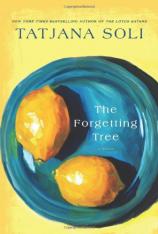Reading Group Guide
Discussion Questions
The Forgetting Tree

1. Why do you think Soli named her novel THE FORGETTING TREE? How does the meaning of the title relate to the characters in the book?
2. How does the Baumsarg citrus farm shape the characters in the novel?
3. How does the loss of Josh Baumsarg affect the family? Forster and Claire react differently. How do you feel about the way they chose to live their lives afterward?
4. Describe Minna. What is it about her that makes such an impression on Claire and her daughters?
5. How does Claire view herself as a mother? Did this perception change after losing Josh? As her daughters grow into adults? In what ways did Claire’s relationships with Gwen and Lucy evolve throughout the novel? What particular dynamics between parents and their adult children does Soli seem interested in exploring?
6. Describe Claire's relationship with her mother, Raisi, and her mother-in-law, Hanni. What life lessons does she learn from them? How does she pass these on to her own children? To Minna?
7. The novel is structured in four parts. Why do you think Soli chose this way to tell it? What do you think of this technique? Does it change the way you experience the story?
8. In Chapter 17, Claire “could no longer tell the difference between her white and Minna’s black” What does she mean by this, and how does this suggest a theme of the novel?
9. Does knowing Minna’s past absolve her from responsibility to Claire? Do you think she overcomes these motivations by the end of the novel?
10. Jean-Alexi states that the “lost got to help the lost in this world.” In what ways are Claire and Minna lost? In what ways do they help each other out of this state? In what ways do they fail?
11. Why does Claire eventually let the farm go? Do you think this is a good or bad thing?
Recommended Further Reading
- Jane Eyre by Charlotte Bronte — Yes, it’s a classic, but it’s so much fun to reread. It was considered ahead of its time in its exploration of a strong female character’s feelings, a proto-feminist text. Plus, you need it fresh in your mind as you learn about the madwoman in the attic, Bertha Antoinetta Mason, for the next book.
- Wide Sargasso Sea by Jean Rhys — My college professor said reading this book will change you, and I agree. The imagery and prose are stunning in their own right, but it is in the telling of an alternate history of the above that the novel really gains its power. Our assumptions and prejudices of the infamous madwoman are turned on their head. It is considered a post-colonial novel in that it tells the story of those whose voice is usually silenced. It deals with racial inequality and displacement. The relationship between the two texts inspired much of the structure of my book.
- Housekeeping by Marilynne Robinson — This is one of my favorite novels of all time. I’ll admit that I took a long time coming to it; the plot description of two young girls growing up in a small town in northern Idaho doesn’t begin to hint of how beautiful and profound the writing is. Hiding in the trappings of a domestic novel is a deeply subversive story about the freedoms to be found in nature and in throwing out society’s expectations. Ruth and Sylvie will haunt you long after the book is closed.
- The Dew Breaker by Edwidge Danticat — Danticat is an exquisite writer. The book is a series of linked short stories. The title comes from the Creole nickname for torturer, in this case referring to the Tonton Macoutes of the Duvalier regimes. Danticat was born in Haiti, and although she has lived in America most of her life, she writes about Haiti’s history with beauty and thoughtfulness.
- The Rainy Season by Amy Wilentz — This is my only nonfiction book on the list, but it is a fascinating look at Haiti after the “Baby Doc” Duvalier regime and the rise of Aristide. The added bonus (especially for readers of my last book, The Lotus Eaters) is that Wilentz is a female journalist navigating a dangerous and tumultuous country, and her vivid writing brings the experience alive for us.
The Forgetting Tree
- Publication Date: September 4, 2012
- Genres: Fiction
- Hardcover: 416 pages
- Publisher: St. Martin's Griffin
- ISBN-10: 1250020425
- ISBN-13: 9781250020420








